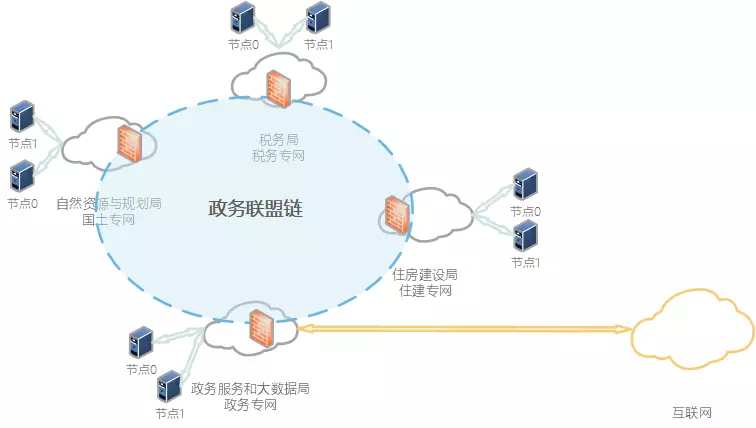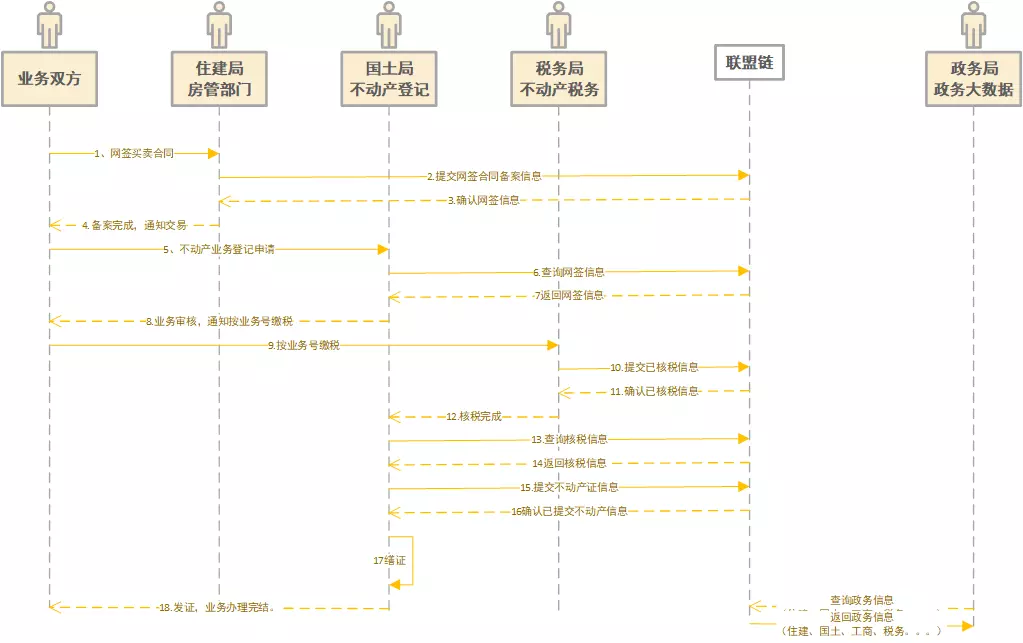1. 背景
为了继续深入研究Fabric的加密通道逻辑,找了一个现成的例子,并修正了一个新手部署可能遇到的问题,
修正的主要点是
- 修改实例代码相对
fabric-samples路径, - 细化一些操作步骤,方便新手傻瓜式运行
1.1 区域链(基于证书准入的联盟链)网络

1.2 业务流程时序

2. 演示系统环境
OS: Ubuntu 18.04
Fabric: release-1.4
Go: go1.14.4 linux/amd64
Docker: 19.03.11
3. 源代码仓库
gitee: https://gitee.com/BCSkill/fcc
4. 实例部署
4.1 克隆源代码
git clone https://gitee.com/BCSkill/fcc.git4.2 部署fabric-samples运行环境
细节的话可以参考《fabric-samples 部署测试》,我们这里不做详细描述,直接运行封装好的脚本
./1-1.hy-sample.sh大概过程中会分为几步,
- 克隆
fabric-samples到当前源码目录 - 下载编译到好的
fabric二进制文件,并解压到fabric-samples/bin,记得将此目录添加到环境变量 - 拉取所需要的Docker镜像
4.3 启动示例网络,创建区块链网络(2个组织,每组织2个节点)
./1-2.startNetwork.sh成功后输出========= All GOOD, BYFN execution completed ===========
4.4 加入第3个组织,2个节点
./2.addOrg3.sh完成后,结果显示========= Org3 is now halfway onto your first network =========
4.5 部署政务智能合约,并实例化
./3-1.installNetcon.sh #合约:网签合同备案
./3-2.installEstateBook.sh #合约:不动产权证书
./3-3.installEstateTax.sh #合约:不动产业务缴税完成后,结果显示
Get instantiated chaincodes on channel mychannel:
Name: estatebook, Version: 1.0, Path: github.com/chaincode/estatebook, Escc: escc, Vscc: vscc
Name: estatetax, Version: 1.0, Path: github.com/chaincode/estatetax, Escc: escc, Vscc: vscc
Name: netcon, Version: 1.0, Path: github.com/chaincode/netcon, Escc: escc, Vscc: vscc此时链环境和链合约已经部署好了。下面开始部署项目的服务端和Web前台
4.6 编译后台。
代码位于appcode/fccserver/src 可自行编译,或直接使用已编译完成的可执行文件
chmod +x appcode/fccserver/src/fccserver启动后台容器
./4.startAppcli.sh
docker logs -f appcli如果启动正常,会显示
[fcc-server] 2019/12/12 03:03:55 system db initiated successfully.
[fcc-server] 2019/12/12 03:03:56 Chaincode client initialed successfully.
[fcc-server] 2019/12/12 03:03:56 Server started on :12064.7 编译和部署前端
前端采用VUE,也可使用其它前端框架或HTML。使用GNINX或其它WEB服务器部署编译后的前端代码。注:当前未使用登录和权限设置
前台部署依赖yarn,《ubuntu 安装最新版本 yarn》
cd ./appcode/fcc-client // 进到Web前端代码目录
yarn install // 安装依赖
yarn serve // 运行前端如果出现
运行成功后,就会显示访问地址
App running at:
- Local: http://localhost:8080/
- Network: http://192.168.31.134:8080/浏览器打开地址,就能看到实例演示了
在线演示
实例依赖Docker 镜像
surou@surou:~/go/src/github.com/chaincode/netcon$ docker ps
+ docker ps
CONTAINER ID IMAGE COMMAND CREATED STATUS PORTS NAMES
f3b34643ff39 dev-peer0.org2.example.com-estatebook-1.0-08d85d200f6268a9c9656f01eac3d5325c44c1d2a93a1115168f63888a27206b "chaincode -peer.add…" 44 minutes ago Up 43 minutes dev-peer0.org2.example.com-estatebook-1.0
9828c2b46b4e dev-peer0.org2.example.com-estatetax-1.0-975867dfc12f233b11d78db94c347aa6b7e94f1d389af7cc892cb8730652c110 "chaincode -peer.add…" 45 minutes ago Up 45 minutes dev-peer0.org2.example.com-estatetax-1.0
9d62c54bfd73 dev-peer0.org2.example.com-netcon-1.0-8285fea29f8449473340c346dc0b6716a084576593325a33707353426d7298dc "chaincode -peer.add…" 46 minutes ago Up 46 minutes dev-peer0.org2.example.com-netcon-1.0
cb870db589c4 hyperledger/fabric-tools:1.4.3 "./fccserver" About an hour ago Up About an hour 0.0.0.0:1206->1206/tcp appcli
33ad280f1f17 dev-peer0.org1.example.com-estatetax-1.0-3284f6d77599d92fad2da964008b3f4bb78573eeb938f40e2110de2089455dc3 "chaincode -peer.add…" About an hour ago Up About an hour dev-peer0.org1.example.com-estatetax-1.0
fa575e9548e3 dev-peer0.org1.example.com-estatebook-1.0-1804a11c573ccbef46e7cda2314c1d76edc2fb52b0f7f9d10ed2024c03343aff "chaincode -peer.add…" About an hour ago Up About an hour dev-peer0.org1.example.com-estatebook-1.0
75c50829fbb8 dev-peer0.org1.example.com-netcon-1.0-4faf315b9f1da5832e386fbae0d05157d269cff3802d770b0e8f135a69027796 "chaincode -peer.add…" About an hour ago Up About an hour dev-peer0.org1.example.com-netcon-1.0
15d29c21ed9a hyperledger/fabric-tools:1.4.3 "/bin/bash" 2 hours ago Up 2 hours Org3cli
d0ce2cc32019 hyperledger/fabric-peer:1.4.3 "peer node start" 2 hours ago Up 2 hours 0.0.0.0:12051->12051/tcp peer1.org3.example.com
9bcf5082db71 hyperledger/fabric-peer:1.4.3 "peer node start" 2 hours ago Up 2 hours 0.0.0.0:11051->11051/tcp peer0.org3.example.com
6f76cca2d809 hyperledger/fabric-tools:latest "/bin/bash" 2 hours ago Up 2 hours cli
04d61faad751 hyperledger/fabric-peer:latest "peer node start" 2 hours ago Up 2 hours 0.0.0.0:10051->10051/tcp peer1.org2.example.com
cdbffd49d7d2 hyperledger/fabric-peer:latest "peer node start" 2 hours ago Up 2 hours 0.0.0.0:8051->8051/tcp peer1.org1.example.com
d59fe735b96d hyperledger/fabric-peer:latest "peer node start" 2 hours ago Up 2 hours 0.0.0.0:9051->9051/tcp peer0.org2.example.com
4caeb0c062e0 hyperledger/fabric-peer:latest "peer node start" 2 hours ago Up 2 hours 0.0.0.0:7051->7051/tcp peer0.org1.example.com
431ad6029954 hyperledger/fabric-ca:latest "sh -c 'fabric-ca-se…" 2 hours ago Up 2 hours 7054/tcp, 0.0.0.0:8054->8054/tcp ca_peerOrg2
4d69e9f76b1b hyperledger/fabric-couchdb "tini -- /docker-ent…" 2 hours ago Up 2 hours 4369/tcp, 9100/tcp, 0.0.0.0:5984->5984/tcp couchdb0
1bcd9f89625f hyperledger/fabric-couchdb "tini -- /docker-ent…" 2 hours ago Up 2 hours 4369/tcp, 9100/tcp, 0.0.0.0:6984->5984/tcp couchdb1
cb46fd7307cf hyperledger/fabric-couchdb "tini -- /docker-ent…" 2 hours ago Up 2 hours 4369/tcp, 9100/tcp, 0.0.0.0:8984->5984/tcp couchdb3
ac996671c144 hyperledger/fabric-orderer:latest "orderer" 2 hours ago Up 2 hours 0.0.0.0:7050->7050/tcp orderer.example.com
c13cc3241b96 hyperledger/fabric-ca:latest "sh -c 'fabric-ca-se…" 2 hours ago Up 2 hours 0.0.0.0:7054->7054/tcp ca_peerOrg1
01ce681daa6c hyperledger/fabric-couchdb "tini -- /docker-ent…" 2 hours ago Up 2 hours 4369/tcp, 9100/tcp, 0.0.0.0:7984->5984/tcp couchdb2